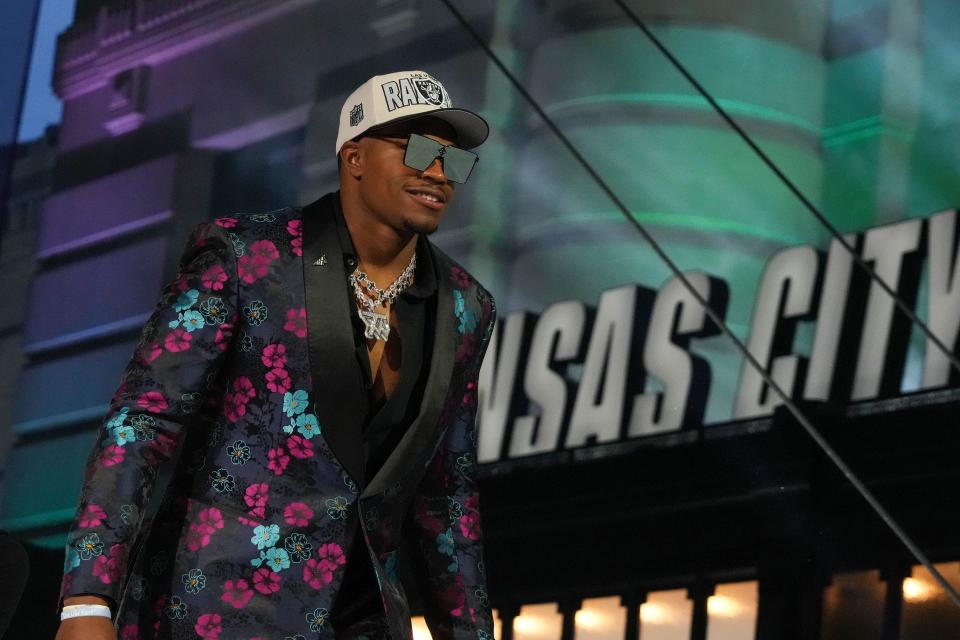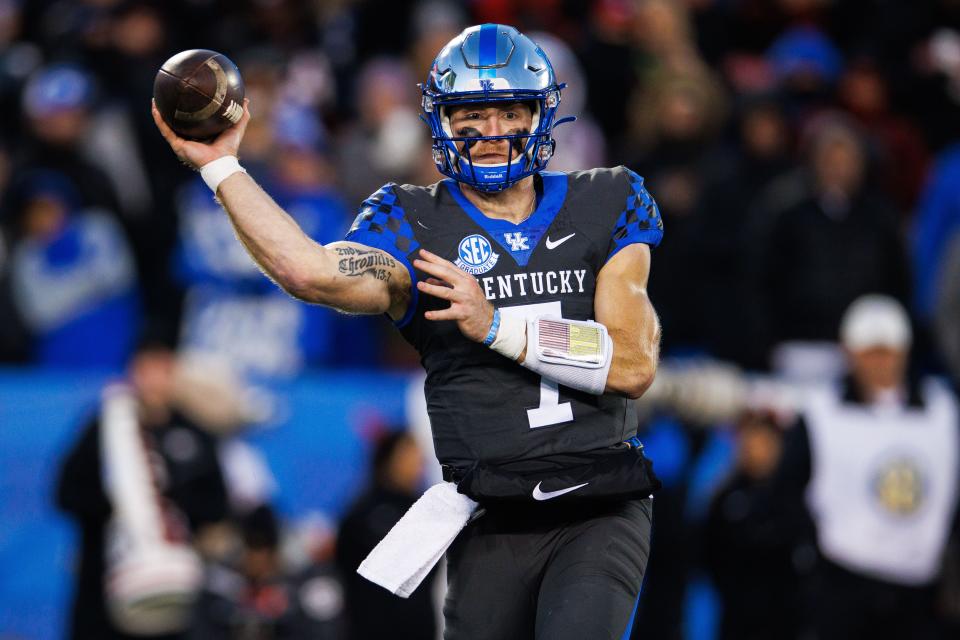Tramel's ScissorTales: Big 12 fares well in first round of NFL Draft, with six picks
The Big 12’s wave of good news in the last year or so continued Thursday night in the first round of the NFL Draft.
Conference stability, a solid television contract that brought relief to campus administrators, Texas Christian making the national championship game. Lots of good things have been happening for a league that seemed imperiled 21 months ago.
Now this. Six Big 12 players were taken in the first round of the draft. The league that went without a first-round pick in both 2021 and 2022 fared very well, ahead of the Atlantic Coast and Pac-12 conferences (seven combined) and not that far behind the Southeastern Conference and Big Ten (nine each). And with just 10 members, the Big 12 has fewer members than its peer conferences.
NFL Draft prowess is a lifeblood of recruiting. Going forward, the Big 12 will not match the huge numbers of the SEC and Big Ten, both of which soon will have 16 members and recruiting advantages galore.
But the Big 12’s mission is not keeping up with the SEC and Big Ten. The Big 12’s mission is staying ahead of the ACC and Pac-12, particularly in talent acquisition. Do that, and the league will be just fine in all the other areas, from television money to playoff success to further recruiting inroads.
More: 2023 NFL Draft tracker: Jaguars select Sooners OL Anton Harrison 27th overall

Six of the 10 Big 12 schools had a first-rounder. And it’s not like the Big 12 had a rash of picks late in the first round.
The Big 12 picks came at No. 7 (Texas Tech edge rusher Tyree Wilson, to the Raiders); No. 8 (Texas tailback Bijan Robinson, to the Falcons); No. 15 (Iowa State edge rusher Will McDonald IV, to the Jetropolitans); No. 21 (TCU wide receiver Quentin Johnson, to the Chargers); No. 27 (OU offensive tackle Anton Harrison, to the Jaguars); and No. 31 (Kansas State offensive tackle Felix Anudike-Uzomah, to the Chiefs).
Sure, OU and Texas are headed to the SEC in summer 2024, so the Big 12 must fortify those defections in terms of talent, but the Big 12 is getting Houston, Central Florida, Brigham Young and Cincinnati.
None of those schools produced a first-round pick Thursday night – all 31 picks came from Power Five schools – but Cincinnati had a first-round pick in 2022, Houston and BYU each had a first-round pick in 2021, Houston had a first-round pick in 2019 and UCF had a first-round pick in 2018.
So it’s not like those schools are strangers to high-caliber NFL talent. And now they’ve got the Power Five distinction to recruit with.
Here’s the list of the other Power Five conferences, with their first-round selections:
SEC: 1-Bryce Young, QB, Alabama; 3-Will Anderson Jr., Edge, Alabama; 4-Anthony Richardson, QB, Florida; 9-Jalen Carter, DT, Georgia; 10-Darnell Wright, OT, Tennessee; 12-Jahmyr Gibbs, TB, Alabama; 14-Broderick Jones, OT, Georgia; 16-Emmanuel Forbes, CB, Mississippi State; 30-Nolan Smith, edge, Georgia.
Big Ten: 2-C.J. Stroud, QB, Ohio State; 5-Devon Witherspoon, CB, Illinois; 6-Paris Johnson Jr., OT, Ohio State; 11-Peter Skoronski, OT, Northwestern; 13-Lukas Van Ness, edge, Iowa; 18-Jack Campbell, LB, Iowa; 20-Jaxon Smith-Njigba, WR, Ohio State; 24-Deonte Banks, CB, Maryland; 26-Mazi Smith, DT, Michigan.
ACC: 19-Calijah Kancey, DT, Pittsburgh; 22-Zay Flowers, WR, Boston College; 28-Myles Murphy, edge, Clemson; 29-Bryan Bresee, DT, Clemson.
Pac-12: 17-Christian Gonzalez, CB, Oregon; 23-Jordan Addison, WR, Southern Cal; 25-Dalton Kincaid, TE, Utah.
More: NFL draft winners, losers: Eagles, Texans ace both picks in first round
College Football Playoff calendar gets it right
The administrators running the College Football Playoff keep getting it right.
The playoff’s management committee — the 10 conference commissions and Notre Dame athletic director Jack Swarbrick — agreed on a calendar for the first two 12-team playoffs, for the 2024 and 2025 seasons.
The calendar is perfect for college football. The managers avoided most head-to-head meetings against National Football League games, scheduled first-round games in a time period that historically has been starved for big-time football and preserved the New Year’s Day tradition of major bowls with the quarterfinals.
CFP executive director Bill Hancock announced the decisions Thursday, after 2½ days of meetings at the Las Colinas Resort in Grapevine, Texas.
The highlights:
∎ First-round games will be played at campus sites, one on Friday night, December 20, 2024, and three on December 21, 2024. Those dates are confirmed.
Last season, the NFL played three games on the third Saturday of December, up from one in 2021. Will the NFL keep stacking that Saturday with games? To be determined.
"I wouldn't want to share any details about our conversations with the NFL, but we have a good relationship with them,” Hancock said.
The NFL is a television ratings monster, but the College Football Playoff could give the NFL pause. If the 12-team playoff had been in effect in 2022, the four first-round games would have been Penn State at Ohio State, Southern Cal at Alabama, Tulane at Texas Christian and Kansas State at Tennessee.
The NFL better have a good matchup if it wants to outdraw a Penn State-Ohio State or a USC-Bama game.
∎ Hancock said that the CFP has narrowed its quarterfinals dates to around New Year’s Day – three games on January 1, 2025, a Wednesday, with the fourth quarterfinal either December 31, a Tuesday night, or January 2, a Thursday. Those games and the semifinals will be staged for at least two years in the traditional major bowls, on a rotating basis.
2024 quarterfinals: Fiesta Bowl, Peach Bowl, Rose Bowl and Sugar Bowl.
2024 semifinals: Cotton Bowl and Orange Bowl.
2025 quarterfinals: Cotton, Orange, Rose and Sugar Bowls.
2025 semifinals: Fiesta and Peach Bowls.
We can debate later whether the playoff should include the bowls or not. I’m fine with it. But if you’re going to include the bowls, don’t scrap the tradition – keep the New Year’s Day dates.
For almost a century, New Year’s Day has meant college football. We’ve lost a lot of traditions in sport. Let’s not lose this one.
∎ The semifinals are expected to be the nights of January 9 and 10, 2025, which are Thursday and Friday. That’s a clear decision to avoid the NFL, which likely will conclude its regular season on January 11-12.
But even aside from avoiding the NFL, there are advantages to such a schedule.
"We want to preserve as much prep time between the rounds as we possibly can," Hancock said.
The 2024 season calendar allows for at least 13-14 days between games for first-round teams, at least 11 days before the quarterfinals, at least a week before the semifinals and at least 10 days before the national championship game, scheduled for January 20, 2025, a Monday night.
The 2024-season championship game is set for Atlanta, followed by Miami the next season.
ESPN reported that the committee still is working on ticket allotments and hotel accommodations for visiting first-round teams. Some smaller college towns would be hard-pressed to handle the lodging demands.
"Our charge is going to be to make what we do fit the same in Knoxville as it does in Ann Arbor as it does in Eugene," Hancock said. "It will be a home game in many ways with pageantry, but there will also be visiting team pageantry, similar to what happens in bowl games."
The CFP still must negotiate a television deal. ESPN has dibs on the first two 12-team playoffs, since it had an existing contract with the playoff through the 2025 season.
And some have suggested that the season start a week earlier, in late August, what now is called Week Zero.
"There are many conflicting interests and opinions about starting the season a week earlier," Hancock said. "But absolutely they talked about it. I don't believe the CFP is the group to make that decision."
That’s OK. The CFP managers had to make a lot of decisions. Virtually all of them right.
Tramel: Cale Gundy tells the inside story of Kyler Murray's recruitment to OU football
Thunder report card: Lindy Waters III
Lindy Waters III’s storybook basketball career continues. Two years ago, Waters was playing low-level minor-league basketball in Enid. Now he’s got a contract through 2023-24 with the Thunder.
Waters showed some value in his second Thunder year, basically winning a lottery with other journeymen to get one of the prized contracts.
Our series of Thunder individual report cards continues today with Waters.
Playing with SGA: A. I don’t know how to explain it, but no one teamed with Shai Gilgeous-Alexander for more success than did Waters. When they were on the court together this season, 213 minutes, the Thunder outscored opponents by 22.6 points per 100 possessions. That’s an outrageous number. The minutes, 213, are not huge but aren’t miniscule. That success led Waters to having the best on/off numbers of any player on the Thunder – OKC was a team-best 10.1 points per 100 possessions better with Waters on the court than off the court.
Defense: B. You’d think guarding on the perimeter, or heck, in the interior, too, would be a major problem for Waters, who isn’t overly athletic. But clearly, he’s holding up to some degree, evidenced by his on/off numbers. Opponents shot just 32.7 percent from 3-point range with Waters as the primary defender, though they also made 59.6 percent against him on shots from 10 feet or closer. Waters contested 9.3 shots per 36 minutes, the highest Thunder figure among non-centers.
Shooting: C. We figured high-caliber shooting would keep Waters in the NBA. So far, he hasn’t produced high-quality shooting but has kept a job. Waters made 35.8 percent of his 3-point shots, after making 36.3 percent a year ago. That’s got to get better, if Waters is to have a long career. Waters knows why he’s on the court; 91 percent of his shots were 3-pointers. Some encouraging signs – Waters shot well (six of 14) in the final four seconds of the shot clock and also made nine of 18 deep shots when tightly guarded.
Aggression: C. Waters is not offensively aggressive. He rarely gets fouled – just 1.4 foul shots per 36 minutes, next-to-last on the squad, ahead only of Kenrich Williams. That lack of aggression means Waters’ assist rate is low (only seven percent of teammates’ baskets with him on the floor came from a Waters assist, among OKC’s lowest figures). But also his turnover rate is low (5.1, best on the team).
Dependability: A. The most underrated statistic in basketball is minutes played. And not how many minutes a player wants to play (load management), but how many minutes a coach wants a player to play. In March, when the Thunder honed in on making the play-in tournament, Waters averaged 16.4 minutes per game. In all other months, Waters averaged 11.3 minutes. Mark Daigneault came to trust Waters more as the games became more important. In the two play-in games, Daigneault shortened his bench significantly, but Waters made the cut, playing 28:23 in the two games combined.
More: Tramel's ScissorTales: Has Russell Westbrook found a longterm NBA home with the Clippers?

Mailbag: NCAA transfer portal
The mass defections from college rosters have some readers wondering what is going on.
Lance: “Deion Sanders at Colorado, is he kicking players on scholarship that he feels have underperformed off the team?”
Tramel: In a word, yes. But give Deion credit. He told everyone, including his players, this would happen. He told his new players, when hired, that they should hit the portal.
Is it unsavory? Yes. Is it a defiance of the collegiate ideal? Yes. Is it new? No.
Coaches have been running off players for decades. They just did it in less public ways than Deion has, and they did it less than Deion did because without the immediate-eligibility of the portal, wholesale roster changes are not as easy.
But coaches from yesteryear were no more honorable than what we see today. We just have more clarity today.
Tramel: SEC field-storming proposal could take away home game from offending school

The List: Second-round quarterbacks
Kentucky’s Will Levis famously sat in Kansas City’s Union Station on Thursday night, waiting to be selected in the NFL Draft.
The call never came. Levis, who ESPN said had a 92 percent chance of being a top-10 pick and a less than one percent chance of not being picked in the first round, now apparently will drop to the second round.
So what does that mean for Levis? What is the history of second-round quarterbacks?
Discounting Kyle Trask, who was picked in the second round of 2021 and still could fashion a good career, here are the 10 quarterbacks taken in the second round in the last 12 years, ranked by NFL success:
1. Jalen Hurts, 2020, OU: Already an NFL superstar, having taken the Eagles to a Super Bowl.
2. Andy Dalton, 2011, TCU: A nine-year starter with the Bengals, who often are woebegone but were 70-61-2 with Dalton as the starter. Now a solid backup.
3. Derek Carr, 2014, Fresno State: 142 games, 142 starts, all with the Raiders. A 217/99 touchdown to interception ratio. Now with the Saints.
4. Jimmy Garoppolo, 2014, Eastern Illinois: Taken by the Patriots, traded to the 49ers after three years, where he was usually maligned but mostly just won, 38-17 as the starter. Quarterbacked San Francisco to a Super Bowl.
5. Colin Kaepernick, 2011, Nevada: 28-30 as the 49er starting quarterback, was mostly disappointing, except for one magical season, when Kaepernick led San Francisco to the Super Bowl. Social upheaval, with Kaepernick serving as a lightning rod, ended his career prematurely.
6. Geno Smith, 2013, West Virginia: 22-29 as an NFL starter, flamed out with the Jetropolitans, but had a renaissance last season quarterbacking Seattle to a 9-8 record.
7. Brock Osweiler, 2012, Arizona State: Played seven seasons, finishing with a 15-15 record as the starter with Denver, Houston and Miami. But Osweiler wasn’t good; he had 37 touchdowns and 31 interceptions.
8. Drew Lock, 2019, Missouri: Osweiler II — 8-13 as the Bronco starter, with 25 TDs and 20 interceptions.
9. DeShone Kizer, 2017, Notre Dame: Cannon fodder for the 0-16 Browns of ‘17, starting 15 of those games. Lasted only two seasons.
10. Christian Hackenburg, 2016, Penn State: Drafted by the Jets, but never played. Literally never played.
Berry Tramel: Berry can be reached at 405-760-8080 or at btramel@oklahoman.com. He can be heard Monday through Friday from 4:40-5:20 p.m. on The Sports Animal radio network, including FM-98.1. Support his work and that of other Oklahoman journalists by purchasing a digital subscription today.
This article originally appeared on Oklahoman: NFL Draft: Big 12 football rallies with six first-round picks in 2023

